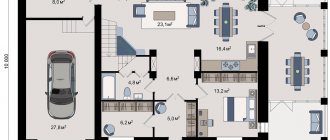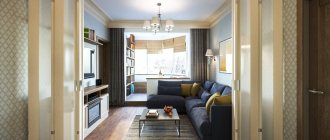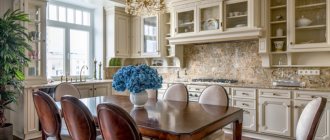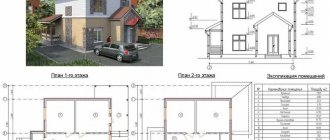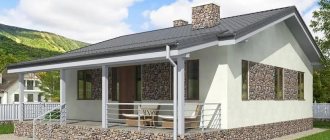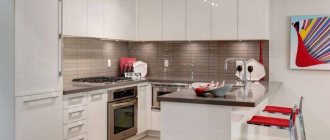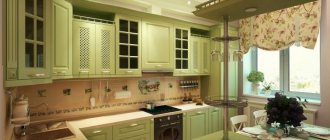Comfortable corner
Most kitchen furniture customers prefer a corner or, in other words, an L-shaped set. For small and medium-sized rooms, this option is often the most practical, since it allows you to equip the kitchen not only with a sink and stove, but also with a comfortable work surface, as well as sufficient storage space. Two of the four walls are used, while one of the corners remains completely free, which allows you to arrange a dining area near it. Let's look at the corner kitchen in detail: let's talk about the advantages, layout options and design features.
Corner kitchen: pros and cons
Pros of a corner kitchen
1. The corner is an ideal base for creating an ergonomic work triangle.
2. One of the corners is completely included in the work area and is functional, which is a practical and rational solution for a small kitchen.
3. Corner modules turn out to be deep and very roomy, and additional storage space in the kitchen, as you know, is never superfluous.
Cons of a corner kitchen
1. Difficulties often arise with designing a corner element, especially if there are uneven walls and various kinds of protrusions in the room. All this, as a rule, increases the cost of both the project and the furniture.
2. In a set for a small kitchen, they prefer to make the corner straight and very compact. Traditionally, a sink is placed here. Subsequently, owners often receive complaints about the inconvenience of using the sink, since there is very little space in front of it. This is especially noticeable if one of the owners has a large build.
About the right choice
Corner kitchens are the most common, so many, without hesitation, immediately order an L-shaped set for themselves. Often, no attempt is even made to “try on” other layout options. But a corner kitchen is not nearly as versatile as is commonly believed. For example, in a narrow, elongated kitchen, a parallel layout (a double-row set along opposite walls) is much more convenient and practical.
Is it worth occupying the entire corner in a situation where the working wall is long and the one adjacent to it is short, if everything you need fits perfectly on one side ( linear layout )? Why overload an already small space?
There are several options for kitchen layout. It's worth considering each of them before making your final choice. And if the angular design turns out to be the most reasonable and ergonomic, then so be it.
Color spectrum
No less important at the stage of designing a kitchen set will be the choice of its shade and lighting fixtures. As for the color of furniture, here you need to proceed from the following recommendations:
- In a classic kitchen, natural wood or a material that imitates it would be appropriate.
- If the room is quite dark and its windows face north or west, it is better to choose bright and light colors (yellow, orange, peach).
- For a kitchen with windows facing east and south, it is better to choose subdued colors (turquoise, beige).
Corner kitchen layout: options
Corner kitchen along two perpendicular walls
Kitchen modules are installed on both sides of the corner. This is the classic layout that is used most often. Suitable for both large and very compact kitchens.
Traditional corner kitchen
Corner kitchen with peninsula
Here, only one side of the furniture corner is located along the wall. The second is positioned perpendicular to it, that is, across the kitchen.
Peninsular corner kitchens
A peninsula corner kitchen is recommended for large rectangular spaces. The peninsula (the free-standing side of the set) divides the space into two zones : the working and dining areas.
This layout allows you to solve several problems at once. Firstly, the owners receive a corner kitchen with an ergonomic triangle and a sufficient number of work surfaces. Secondly, effective zoning of a large room is carried out. In addition, the peninsula often serves as a bar counter.
Corner kitchen with bar counter
This set usually has a U-shape. However, different options are possible, because the bar counter can be located not only on the edge, but also in the middle (F-shaped plan).
Corner kitchens with bar counter
For a small kitchen, a bar should be planned only if there is no intention of setting up a full-fledged dining area here. Only then does the presence of this element become truly necessary and appropriate.
Zoning the kitchen space
Visually highlighting areas in one room will be successful if you use some non-standard options for the kitchen. Designers recommend dividing the space using finishing materials for walls, floors, ceilings, lighting, low furniture, and various accessories. Basically, they separate the work area from the dining area. To properly plan your space, you need to listen to some tips.
Work zone
There are several ways to designate a work area. For large rooms, it would be a good option to have furniture - a bar counter, an island, a sofa. It is better to zone small rooms using finishing materials. More often they use different floor coverings that differ in texture, color, and material. A stylish solution is to install a podium.
You can highlight a work area in narrow kitchens using ceiling trim. Multi-level ceilings are emphasized with lighting from above. A chandelier is installed above the dining area, and several spotlights are installed above the work surface apron. If the dining room area allows, the food preparation area is separated by screens and sliding modules.
Dining or dining area
There are several ways to create a cozy atmosphere in the dining area. Choosing the right one will depend on personal preferences and financial capabilities. The most popular option is decorating adjacent walls. The following materials are used for zoning:
- Photo wallpaper, contrasting plaster;
- 3D panels for walls;
- Cork covering with imitation of natural materials;
- Mosaic, tiles for vertical surfaces;
- Decorative rock;
- Wall decor (paintings, panels, photographs, etc.).
Spectacular sconces and pendant lamps will help highlight the dining area. An excellent assistant would be unusual fittings that differ in color from the elements in the set, bright upholstery of chairs, and various textiles.
Work triangle in a corner kitchen
The vertices of the ergonomic work triangle are the refrigerator, sink and hob . If we call our triangle ABC, then at point B there should always be a sink. The location of the refrigerator and stove may vary.
Ergonomics of a corner set
Ideally, you should strive to ensure that the triangle is approximately equilateral. Fortunately, the corner layout of the kitchen contributes to this.
The order of the elements of the working triangle corresponds to the sequence of cooking: take it out of the refrigerator, wash it, cut it, and heat it.
Correct layout of a corner kitchen from an ergonomic point of view
Of course, it is not always possible to comply with the triangle rule, because you have to adapt to the initial conditions. But if the kitchen is very large, you should try to place the main elements on both sides of the corner .
How to avoid mistakes?
The most common mistakes made when designing kitchen units include:
- Ignoring measurements of the ratio of the top and side planes or the angle of inclination of the wall. This leads to the fact that the cabinets either do not fit, or a gap appears between them. This can only be corrected by leveling the wall or making new furniture, which entails significant costs.
- No allowance. When calculating the dimensions of the headset, it is necessary to take into account an error of 10 mm. In order for all sections to fit into their niches without problems, the length of the set must be at least 1 cm less than the length of the wall along which they are planned to be placed.
Kitchen design in three tones Source xn--80akibkoqohe.kiev.ua/
Kitchen corner
The internal corner of the kitchen set can be either straight or beveled . Which one should you prefer?
A beveled corner has a number of advantages. Firstly, this design is not complicated in any way: you just open the door and get full access to the interior space. There is no need to include additional “filling” in the form of any roll-out or retractable elements. Secondly, the beveled corner modules are very spacious. Thirdly, there is a lot of free space in front of this angle. This makes using a corner sink or stove much more convenient.
Sloped kitchen corner with corner sink
Corner kitchens with beveled corners
If the beveled module turns out to be excessively deep, there are also disadvantages. So, it becomes difficult to reach the wall above the cabinet, which is why washing the apron in this area turns into not the easiest task. If you choose a beveled option, make sure that the module is not too deep.
Right angles are preferred for kitchens in the minimalist style and when equipping compact spaces. The fact is that beveled modules take up more space.
Right angle L-shaped kitchen
A right internal angle is not as simple as it seems. This is where difficulties arise with access to internal content. But don’t let this scare you: everything was invented a long time ago.
To expand access, the door of adjacent corner modules is often made folding - actually consisting of two facades connected by hinges. This greatly increases the practicality of the headset.
Doors for corner kitchen modules
For deep corner sections with difficult access, there are a variety of pull-out and pull-out “fillings”. Rotating mechanisms are popular, known in many countries as “Lazy Susan”.
Filling for corner modules in the kitchen
Another interesting option is traditional pull-out cabinets with atypical corner facades.
Options for equipping a corner section in the kitchen
The issue of the design and filling of corner modules is resolved individually between the customer and the contractor. When you go to order a new corner kitchen, know that there are options. If they are not offered to you, ask yourself or look for another manufacturer.
Material selection
The frame of the headset is usually made of chipboard. To create facades use:
- veneered or laminated chipboard;
- veneered or laminated MDF, which can additionally be varnished;
- natural wood (today this option is quite rare and is very expensive, more often a veneered facade is used instead of wood);
- glass - usually used to create an overlay panel or individual inserts;
- metal - more often found in decoration.
Ledge in the corner of the kitchen
In many old and new homes, the kitchen work area is accompanied by a ventilation shaft. The protrusions are different: wide and narrow, deep and insignificant. What to do if it is in this place that you plan to place the top of the furniture corner?
All over the world, people live in houses with various projections, beams, boxes, and crossbars. But it is not common practice everywhere to be “ashamed” of these design features and hide them if possible. Look how Europeans deal with a deep kitchen ledge : they simply tear apart the kitchen set in this place, without trying by hook or by crook to connect the two sides of the corner into a single whole.
Ventilation shaft in the corner of the kitchen: how to plan cabinets?
Of course, if the ledge is shallow , there is no point in dividing the kitchen into parts. The obstacle can be gracefully circumvented. However, it is better to abandon the upper cabinets in this place, leaving the area empty or decorating it with corner shelves.
Ventilation ledge in the kitchen
Room measurements
First you need to define:
- ceiling height;
- length and width of the room;
- distance between floor and window, window and ceiling;
- evenness of the corners (ideally, the angle should be strictly equal to 90 °; if you deviate from this indicator, the walls must be leveled).
The list of measurements includes projections and communications.
If any discrepancies are identified (differences in height, width of the room), the defects are eliminated. If this cannot be done, then the errors are taken into account when choosing furniture. If there is a bulge in the upper half of the wall, it will prevent you from hanging a cabinet there. Having calculated the area of the kitchen, you can choose the principle of placing furniture here.
Semicircular island in the kitchen Source dizainkuhni.com/
What to place in the corner of the kitchen?
Most often, a sink is cut into a corner - this corresponds to the principles of the ergonomic triangle. However, installing a sink near a window is becoming increasingly popular in our country. In this case, the corner can be given to the oven. This scheme is suitable for a fairly large kitchen, because the cabinet under the oven must be sloping, which, as we have already said, eats up more space.
Corner kitchen layout
The top of the corner can be given not to the sink or oven, but to the section with the refrigerator. This kind of corner kitchen design is almost never seen in our country, so the solution is perceived as very original. Much more often, a hob with a hood is placed in a corner.
Corner refrigerator from the Italian brand Norcool
Each of these decisions has the right to life. Don’t rush to approve a plan with a sink in the corner - perhaps a different configuration will be more successful for you. But be sure to keep in mind the rule about the ergonomic triangle: it is advisable to place the sink somewhere in the middle between the stove and the refrigerator.
The best design solutions
Designers, furniture makers, and kitchen interior artists use three pillars when creating a furniture design. What do they pay attention to?
The first is on a grid of sizes (mm), which is presented in a table where:
- The height corresponds to the parameters - 116-1750.
- The actual width for design is 146-896.
The full geometry and volumes of the products are shown in the photo, where the exact measurements are indicated.
Corner kitchen design: equipment
If the “shoulders” of the corner kitchen are quite short, each lower section can be accompanied by an upper cabinet. Otherwise, there will not be enough space to store utensils.
If the kitchen is long, the abundance of upper modules will make the work area bulky and heavy. This will deprive the room of lightness and comfort, especially if the facades are quite dark. Upper cabinets should be hung only on one side of the corner, and on the other, for example, a hood, shelves, or wall decor should be placed.
Another design option for a large kitchen: on one side of the corner there are traditional pairs of upper and lower sections, and on the other there are fully closed column cabinets with a built-in refrigerator. Tall, solid cabinets look like a wall surface, making them easier to perceive than cabinets with wall cabinets.
******
Which color to choose
As already mentioned, light shades should predominate in the interior design of a direct kitchen. They will help to visually expand the room, fill it with light and air. It is not recommended to choose dark furniture fronts that will put pressure on the owners; the same goes for the ceiling - it should be just white, without options.
As for the floor, you can get creative here. Laminate, ceramic tiles, linoleum, and porcelain tiles are suitable for its arrangement. You can also equip a glossy self-leveling floor. As for its color, it can be either light or dark - the main thing is that such a floor is in harmony with the interior of the kitchen.
Light shades should also prevail in textiles. Dark curtains or curtains will limit the access of sunlight to the room, which means it is better to avoid using them. A good option would be light curtains, blinds or Roman blinds.
First steps
Before you come up with design options for your kitchen set, you need to understand what kind of furniture you can put in your kitchen. To do this, start by assessing the room and taking measurements. General plan of action to get started:
- 1
Look around the room. What is it like - light, dark, small, spacious. Is it possible to divide it into two or three zones, where is the window, is there enough space for a table. You don’t need to draw a plan yet, just try to see the big picture and form an idea of how to properly design a kitchen for this room. - 2
Make a plan. Draw it on a piece of paper, measure the length of the walls, the height of the ceilings, how much space you have near the window sill, write down the location of pipes, ventilation shafts, gas water heater, determine where the switches and sockets are located, measure the existing household appliances. This will allow you to avoid making mistakes when planning how the furniture will stand. - 3
Determine your needs. Some people cook often, others prefer to bake a lot, others throw cocktail parties - everyone has their own preferences. The kitchen should reflect them. In the same paragraph, write down all the necessary areas (stove, sink, work surface, dining table) and equipment that will need to be placed in the room. At the same time, write down what you will store in the room, what drawers and cabinets will be needed, etc.
After these three simple steps, you already have a base on which to try out design ideas for your kitchen set.
Tip: The next step is to study models that are already on sale. It will help you understand how kitchens are generally furnished and what options can be used for a particular room. Look at the ready-made kits, save a selection of the best ideas for yourself, and then start creating your own project based on them.
Internal filling of cabinets: what should not be forgotten?
It’s not difficult to figure out how to come up with a kitchen set design. It is difficult to implement everything without missing important details. When planning the number of cabinets, shelves, drawers and other contents, do not forget about the following details:
- Next to the sink you need a drawer for freshly washed dishes;
- under the sink next to the work surface you need a place for a trash can;
- spoons, forks, plates, knives and other utensils should be located near the place where you cook;
- if the upper shelves of the cabinets are glazed, you can put grandma’s beautiful set there. If they are closed, then this is a good place for pots that are rarely used;
- near the stove you need to plan a place for potholders, an electric lighter, not far away, but so that splashes from food do not fall on the shelf, it is worth placing a shelf for spices;
- There should be a shelf next to the sink for paper towels and other useful items. Somewhere nearby (perhaps under the sink or in a nearby cabinet) you need to allocate space for household chemicals. You cannot store dishes or anything edible with it;
- A storage area is usually designated next to the refrigerator. All products are stored there, except for spices needed during cooking;
- the dining area should be separate from the food preparation area and as far away from it as possible. If space is at a premium, consider replacing your dining table with a counter and saving square footage. Family gatherings can also be held in the living room.
These are not all the little things that need to be taken into account, but the most important ones. When planning, study ready-made solutions to get ideas. Nowadays there are many different convenient ways to store kitchen utensils, including pull-out cabinets for everything.
Let's sum it up
Independently planning the details of the furnishings of your future home is an exciting and responsible process that can drag you in because you are actually creating a picture of a future happy life in a new place in your head, and at the same time repel you, since after all, planning involves studying a lot of difficult and not for all interesting nuances. However, if you firmly take up the matter and approach it with all responsibility, everything will turn out just fine.
Everyone knows that a kitchen is needed not only for cooking, but also for relaxation, as well as pleasant gatherings with the whole family or with guests. That is why, even with limited space, it is necessary to ensure maximum comfort in this room. In a special article we will look at kitchen designs with an area of 10 sq.m.
